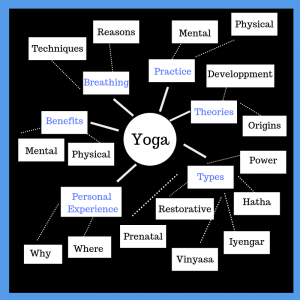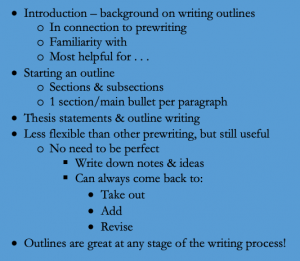One of the most difficult parts of a writing assignment is trying to start. Often, writers can be intimidated by the enormity of an assignment or struggle to begin at an appropriate point.
Brainstorming can help you generate ideas, narrow them down, and associate ideas with other ideas. This procedure can be highly variable; writers can experiment with finding ideas through research and literature, or bouncing ideas off of peers. Some other brainstorming strategies include:
Clustering/Mapping
This process can help you come up with main ideas, identify supporting ideas, and see the connections among your ideas, which can help with your organization.

- Begin by writing your main topic or subject in the middle of a page.
- As fast as you can, free-associate or jot down anywhere on the page as many words as you can think of associated with your center word.
- If you get stuck, go back to the center word and launch again. Speed is important and quantity is your goal. Don’t discount any word or phrase that comes to you, just put it down on the page.
- Jot words for between 5-10 minutes. When you are finished you will have a page filled with seemingly random words.
- Read around on the page and see if you have discovered anything or can see connections between any ideas.
- Continue this process as you think of new ideas.
Freewriting
Freewriting is a great way to generate ideas without worrying about how good they are or about your writing. The goal of freewriting is to write as much as possible in a short amount of time without stopping to edit or change your writing or your ideas.
- Start by setting a timer for 5 to 10 minutes and write about the topic/idea that you want to use in your paper without stopping until the time goes off.
- Once you’ve written for 5 to 10 minutes, read over what you wrote and choose a few of the most interesting or strongest ideas.
- Use these strongest and most interesting ideas to freewrite again, developing even more ideas with this narrowed focus.
Repeat this process as many times as you want until you feel you have the best ideas for your paper.
Topic Outlines
Outlining tends to be the most linear way to prewrite and one that most writers are familiar with. In prewriting, outlining is most helpful with developing and connecting the structure and argument of your assignment. Often, in identifying the larger elements of an assignment (the thesis, main point of a paragraph, etc.) and putting them into a rough outline, it becomes easier to fill in what goes under each outlined section.
- Start your outline (whether in a digital document or handwritten on paper) by laying out your sections and subsections. A good rule of thumb is to start with a bullet/section per paragraph, and then expand from there.
- Filling in a thesis for argumentative/essay assignments (even if it’s rough or really only a placeholder) can help you better figure out the structure of your assignment. Then, for each paragraph, think about the main point of that paragraph and how it connects to your thesis/introduction. You can keep working down from there if you want, all the way to writing the ideas and even sentences you’ll want to include in that paragraph.
- Though outlines can be a little less flexible than other kinds of prewriting, don’t be too worried about everything making total and complete sense when you write it; like other kinds of prewriting, outlining is about getting stuff down so you can get to work writing, so it’s okay to just use it to jot down notes and ideas as you go.
- Outlines can be really useful when starting an assignment, but it’s also good to remember that crafting an outline at any stage in the process is likely to help you better recognize and organize your structure. It’s never too late for an outline!
Return to the Prompt and Rubric
Instructors often provide information and expectations on the assignment sheet, and many include rubrics that will indicate how they’ll assess your paper. To get started writing, underline keywords that address the assignment’s purpose, content, guidelines, and format.
